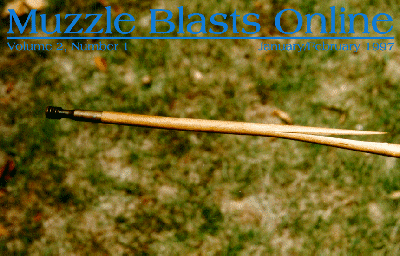|
Muzzle Blasts Online |
|
...for the muzzleloading enthusiast |
|
The muzzleblasts.com domain, subdomains, content, etc., are neither affiliated with the NMLRA nor its paper magazine Muzzle Blasts |
|
Muzzle Blasts Online |

|
|
|
|
|
|
Ramrod Rights and Wrongs
| TABLE 1 | |||
|---|---|---|---|
| Comparison of load-bearing capacities* of selected native American woods. | |||
| Common names of tree species strength | Maximum crushing (PSI/lb) | Maximum shearing strength (PSI/lb) | Modulus of elasticity** |
| Hardwoods | |||
| Ash, black | 5970 | 1570 | 1.60 |
| Ash, white | 7410 | 1910 | 1.74 |
| Beech | 7300 | 2010 | 1.72 |
| Birch, yellow | 8170 | 1880 | 2.01 |
| Cherry, black | 7110 | 1130 | 1.49 |
| Elm, American | 5520 | 1510 | 1.34 |
| Elm, rock | 7050 | 1920 | 1.54 |
| Hickory, pignut | 9190 | 1980 | 2.26 |
| Hickory, shagbark | 9210 | 2430 | 2.16 |
| Locust, black | 10180 | 2480 | 2.05 |
| Maple, red | 6540 | 1850 | 1.64 |
| Maple, sugar | 7830 | 2330 | 1.83 |
| Oak, southern red | 6090 | 1390 | 1.49 |
| Oak, white | 7440 | 2000 | 1.78 |
| Walnut, black | 7580 | 1370 | 1.68 |
| Softwoods | |||
| Cedar, Port Orford | 6250 | 1370 | 1.70 |
| Fir, Douglas*** | 6230 | 1510 | 1.49 |
| Hemlock, mountain | 6440 | 1540 | 1.33 |
| Pine, loblolly | 7130 | 1390 | 1.79 |
| Pine, longleaf | 8470 | 1510 | 1.98 |
| Pine, slash | 8140 | 1680 | 1.98 |
* data from ``Wood Handbook'', published in 1987 by the Forest Products Laboratory, U.S. Dept. Agriculture, Washington, DC 20402.
** Modulus of elasticity is defined as the ratio between the load applied per unit area and the deformation caused by that load.
*** values are for trees harvested from Utah, Colorado, Arizona, and New Mexico; fir trees grown in coastal areas have far less load-bearing capacity.